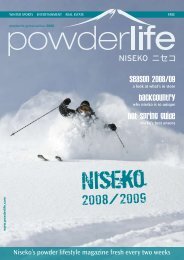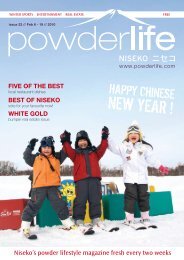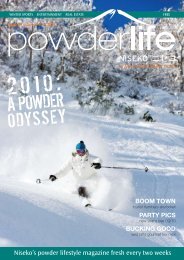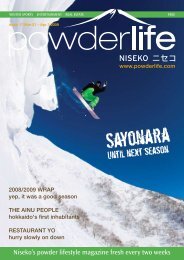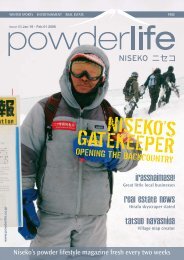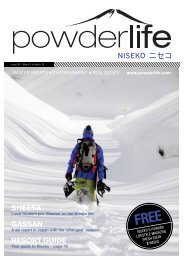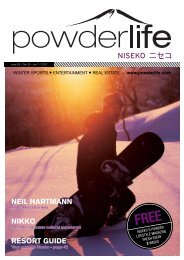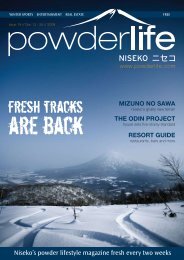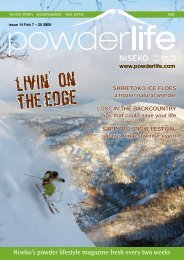RESORT GUIDE AKIO SHINYA DANJIRI MATSURI - Powderlife
RESORT GUIDE AKIO SHINYA DANJIRI MATSURI - Powderlife
RESORT GUIDE AKIO SHINYA DANJIRI MATSURI - Powderlife
You also want an ePaper? Increase the reach of your titles
YUMPU automatically turns print PDFs into web optimized ePapers that Google loves.
TRAVEL FEATURE // kishiwada danjiri matsuriPHOTOGRAPHY AND WORDS BY // ross cole-hunterHUNDREDS of childrenwalk one after theother around acorner, all dresseduniformly in happis (Japanesesummer festival clothing). Theirsize and age steadily increasefrom children to teenagers.They hold a giant rope, pullingsomething around the corner thatwe couldn’t yet see. The soundsof drumming, cheering, cymbalsand festival flutes got louder andfaster and the hidden object, agiant wooden danjiri (a portableshrine on wheels), came into view.After several minutes under therelentless baking summer sun inOsaka, the cavalcade stopped pullingthe danjiri as it approached the corner.The music quietened and the ropeslackened. One last quick breath wastaken before charging at full pace,pulling the rope with as much zestand zeal as their fatigued bodies couldhandle, jerking the cart violently aroundthe corner with the use of woodenlevers underneath the cart. The menpulling the danjiri don’t slow down andkeep running and pulling the woodenchariot off into the distance, with asmuch vigour as they can muster. Theirstamina and flamboyant performanceis as much of a representation of theircommunity as is the craftsmanship oftheir danjiri.The Kishiwada Danjiri Matsuri issteeped in history, dating back to early18th century when the ruling lordswould allow peasants a single day toenter the castle. Carpenters, musiciansand fisherman from each communitywould race to be the first to show offtheir wares, and to bask in the attentionand admiration of their lord. Thistradition has continued, though it hasadapted to match a modern Japan.There are 32 communities, each withtheir own danjiri that they race aroundthe streets between Kishiwada stationand Kishiwada Castle. Children areintroduced to the festival in simpleand safe roles, and as they age theyare given more significant roles in thefestival.There are many danjiri festivalsin Japan, but Kishiwada City’s isconsidered to be the most famous andalso the most dangerous with deaths,severe injury and property damagenot uncommon. The festival involveshundreds of people pulling a 4,000kgornately carved wooden cart at highspeed through narrow alleys andaround tight corners. These exquisitely“A festival that is frequently touted as beingJapan’s ‘most dangerous festival’”carved carts are quite top heavy,and because of the rapid changes indirection that are required, they areprone to topple over, causing damagenot only to the cart, but also to thepeople riding it and any spectatorsand property in the way. Buildings inthe area actually have special danjiriinsurance policies in case of such anaccident occurring.It may sound sadistic, but there issomething strangely fascinating aboutwatching a festival that is frequentlytouted as being Japan’s ‘mostdangerous festival’ and waiting forthe carnage to unfold in front of yourvulturous eyes. It’s not thatI would wish that any of the peoplewould be hurt; but anticipation anduncertainty is certainly causefor excitement.To the people of Kishiwada, thisfestival is the most important day of theyear. In fact, their calendars start andfinish in September to coincide withthe festival.As the sun goes down you can feelthe festival dropping a few gears. Theonce frenetic danjiri are now decoratedin dozens of illuminated lanterns andthe exhausted men can relax andperform a slow victory lapto the crowd.Details:Where: Kishiwada City, Osaka Pref.Getting there: Frequent trains fromOsaka CityWhen: Mid September61powderlife issue 31 // January 22 to February 4, 2011 www.powderlife.com



